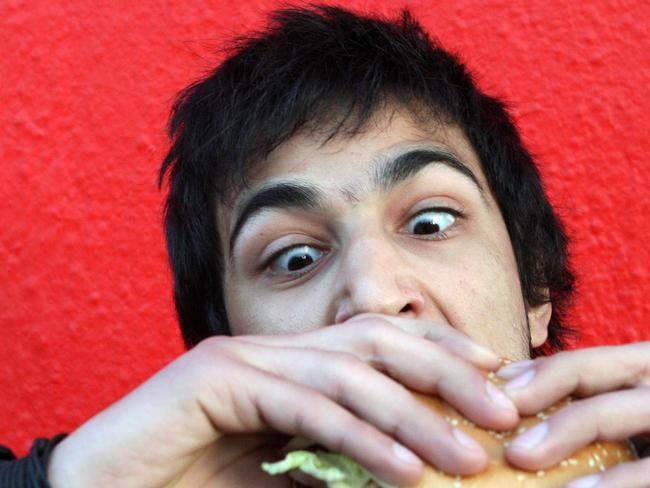How online food deliveries are driving up the obesity rate
Australians are ordering 70 million meals a year from online delivery services. But the trend is contributing to the nation’s obesity crisis due to a whopping number of kilojoules.
Illness
Don't miss out on the headlines from Illness. Followed categories will be added to My News.
Exclusive: Too lazy to cook or even shop, Aussies using online food delivery services are ordering meals so full of kilojoules they contain an entire day’s energy intake in a single sitting.
More than 68 million meals a year are now being ordered in, two meals every second, and online food delivery services have been identified as the new frontline of the obesity epidemic.
A new survey of 2000 people has found when they order food online, two in three Australians are picking unhealthy options and one in three people upsize their meal.
More overweight Australians are also malnourished
Fears for nation’s obese toddlers
The Cancer Council’s LiveLighter campaign conducted the survey and its manager Alison McAleese said it was worrying that some of the online meal deals contain almost an entire days kilojoules in a single serve.
Examples include Hungry Jack’s Whopper Hungry Tamers meal offered on online delivery service Menulog which contains 8490 kilojoules, just short of the daily 8700 kilojoules recommended for an adult.
Other high energy meals offered online include Pizza Hut’s cheese lovers pizza which has 7471 kilojoules and KFC’s favourites box 5118 kilojoules.
“When we rely on buying food outside of home or being delivered via online services we’re more likely to eat more, make unhealthy food choices and spend more money than we normally would when preparing and cooking meals at home,” LiveLighter Campaign Manager Ms McAleese said.

The LiveLighter survey found:
• One in 10 order food online at least once a week;
• One in six of eat a meal or snack bought outside of our homes every day;
• Over a third of Australians (36%) upsized their meal when ordering online;
• A quarter of Australians (26%) upsized their meals when eating at fast food outlets.
Uber Eats revealed last year that hot chips were the most ordered menu item using its delivery service and said that Australians had ordered 83 million chicken nuggets in 2018.
Menulog said pizza was its most ordered dish making up 29 per cent of all orders followed by Indian food 19 per cent and Thai food 14 per cent.
To keep their calorie intake under control Australians could try cooking healthy meals in bulk and freezing the left overs for later us,” Ms McAleese said.
“When ordering in look for meals that contain lots of vegetables, skip the drink and choose meals that aren’t fried,” she said.

LiveLighter’s website has some freezer friendly recipes, suggestions for healthy snacks and healthy recipe swaps.
Baker Institute‘s obesity expert Professor John Dixon said ordering in food did not have to be bad for your weight with many kilojoule controlled meals could be delivered to the home from weight loss companies.
It important to understand that obese people needed to eat more to feel satisfied, he said.
“They will order more food, that is part of the disease. If they have a significant weight problem they will eat a lot in an evening meal and still look for more,” he said.
One in three Australians are now obese and the problem is costing the health system almost $4 billion a year.
Obesity rates have almost doubled from 18.7 per cent in 1995 to 31.7 per cent in 2017-18 according to the Australian Bureau of Statistics.
Young women aged 25-34 are the group getting fattest the fastest.
Their waistlines expand by an average of 8.4 centimetres in the 12 years from 2000 to 2012 and they stacked 590g to their weight each year.

Uber Eats said its customers were becoming more health conscious and “healthy’ was now in the top ten searches for Australia particularly in the summer months.
“ At lunch times however, healthy moves to top 5,” a spokeswoman said.
“Vegan” has become a more popular search over the past six months, sneaking into the top 20 search terms.
In Melbourne and Sydney the top three healthy food choices are:
*Burrito Bowl
*Build your own bowl from Fishbowl
*Grilled chicken
Research conducted by Empirica Research for Uber also reveals more than half of (58 per cent) Australians agree that there are more healthy options available via food delivery apps.
However, only 1 in 5 (19 per cent) say they tend to eat healthier when they order via food delivery apps compared to when they cook.
Originally published as How online food deliveries are driving up the obesity rate


